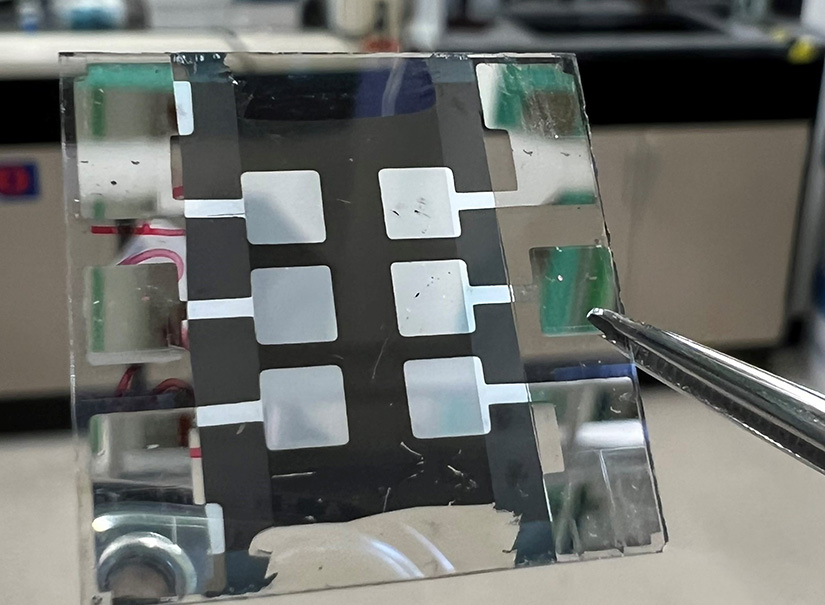Perovskite challenges are addressed by a new fabrication process Latin American Photovoltaic Journal

Researchers at the US National Renewable Energy Laboratory (NREL) are developing a method for producing solar power from perovskite that is efficient and stable.
A new approach to making perovskite solar cells developed by NREL researchers addresses previous problems and leads to devices with high efficiency and excellent stability.
The development of highly stable and efficient perovskites based on a mixture rich in bromine and iodine is essential for creating tandem solar cells. However, problems of separating the two elements under solar cell operating conditions, such as light and heat, limit the device’s voltage and operational stability. This problem is often exacerbated by the easy defect formation associated with the rapid crystallization of bromine-rich perovskites with anti-solvent processes.
“This new growth approach can significantly suppress phase separation,” says Kai Zhu, NREL principal investigator, principal investigator on the project, and lead author of the new paper.Synthetic tissue engineering of highly stable wide-bandgap perovskite solar cells(Modular architecture of highly stable broadband perovskite solar cells). NREL co-authors are Chi Jiang, Jinhui Tong, Rebecca Schidt, Amy Lux, Robert Terawat, Axel Palmstrom, Matthew Hautzinger, Stephen Harvey, Steve Johnston, Laura Schilhas, Brion Larson, Emily Warren, Matthew Beard, and Joseph Perry. Other research associates are affiliated with the University of Toledo.
The new method solved the problem of separating the two elements and produced a broadband solar cell with an efficiency greater than 20% and a photovoltaic voltage of 1.33 V. Efficiency barely changed during 1,100 hours of continuous high-temperature operation. In the end, the researchers came up with an all-perovskite tandem cell that achieved an efficiency of 27.1% with a high photovoltage of 2.2 V and good operation stability.
In a tandem cell, a narrow bandgap layer is deposited on top of a wide bandgap layer. The difference in bands makes it possible to capture a larger part of the solar spectrum and convert it into electricity.
The new method builds on work published earlier this year by Zhou and colleagues, which inverted the typical perovskite cell. Using this inverted architecture allowed the researchers to increase efficiency and stability and to easily integrate tandem solar cells. In the end, they came up with a perovskite solar cell that had an efficiency of 24% and would retain 87% of its output after 100 days.
In the recent research study, the NREL-led group used the same structure in that they used a solvent-based antipruritic applied to a chemical crystal to create a uniform perovskite film. Then they went further, and the new approach was based on what is known as gas quenching, where a stream of nitrogen is blown over the chemicals. The result was a perovskite film with better structural and optoelectronic properties.
The previous anti-solvent method allowed the crystals to grow rapidly and evenly within the perovskite film, crowding each other creating defects where grain boundaries meet. A new gas quenching process, applied to high-bromine perovskites, forces the crystals to grow together, tightly packed from top to bottom. Researchers have found that this significantly reduces defects. The top-down method of growth forms a tiered structure, with more brome near the top and less in the bulk of the cell. The researchers reported that the gas quenching method was also statistically more reproducible than the anti-solvent method.
The researchers also tested argon and air as drying gases with similar results, indicating that the gas cooling method is a general way to improve the performance of broadband perovskite solar cells.
The new growth method demonstrated the potential of high-performance perovskite-based tandem devices and prompted the development of other perovskite-based tandem architectures, such as those incorporating silicon.
The work was published in the new issue of the journal science.
This content is protected by copyright and may not be reused. If you would like to collaborate with us and would like to reuse some of our content, please contact: [email protected].

“Professional problem solver. Subtly charming bacon buff. Gamer. Avid alcohol nerd. Music trailblazer.”




:quality(75)/cloudfront-us-east-1.images.arcpublishing.com/elcomercio/6NEH6FMKYBCU7JJWZ5GVRZKTRM.jpg)
/thumbs.vodgc.net/1-14-FnXFWZ1684253239488_1080P.jpg)





